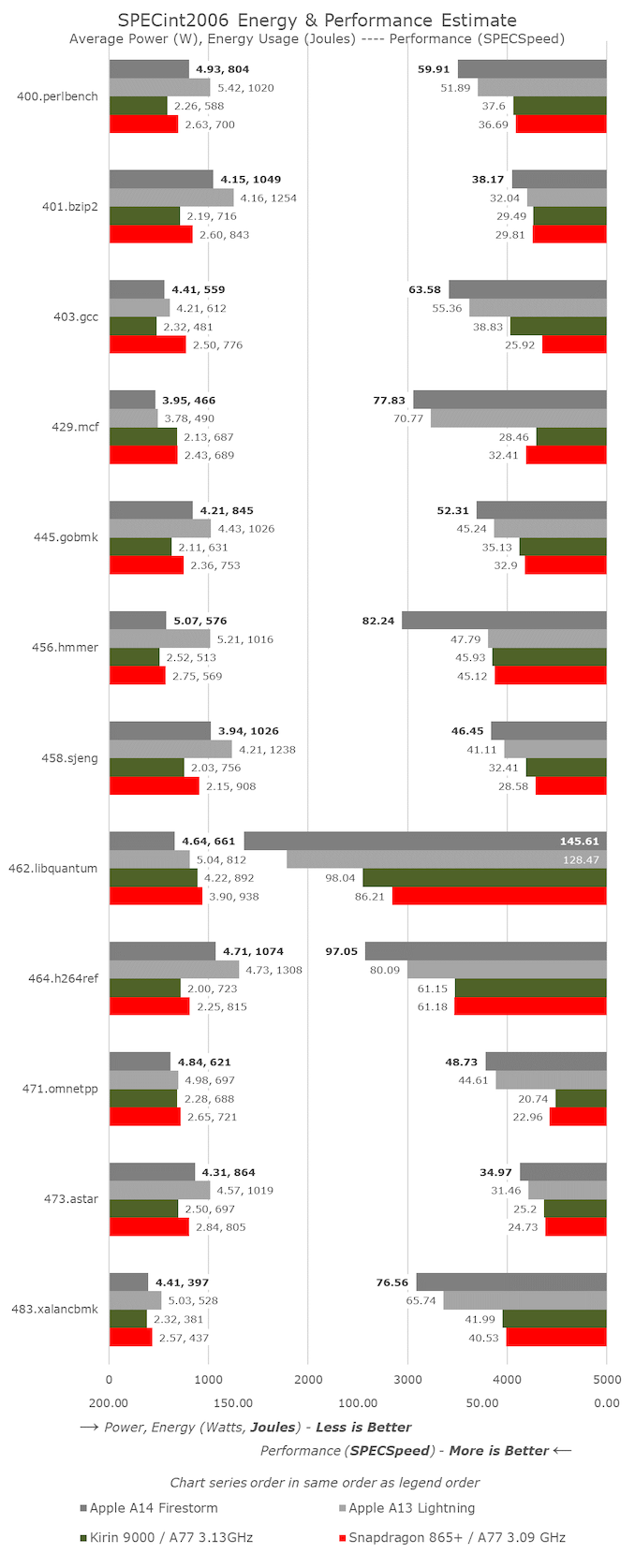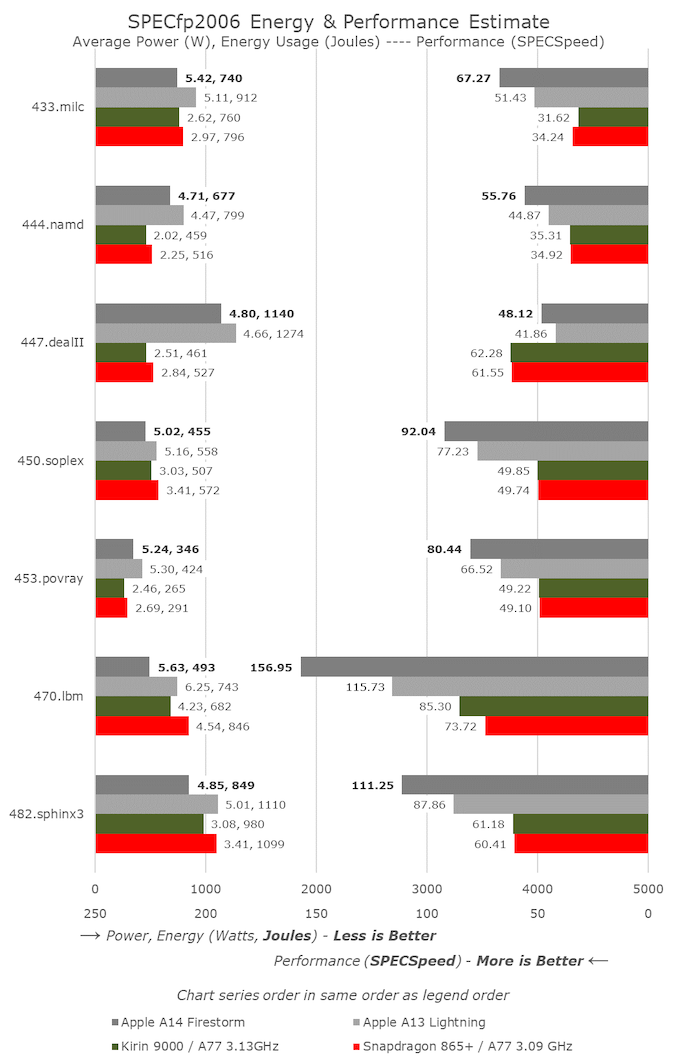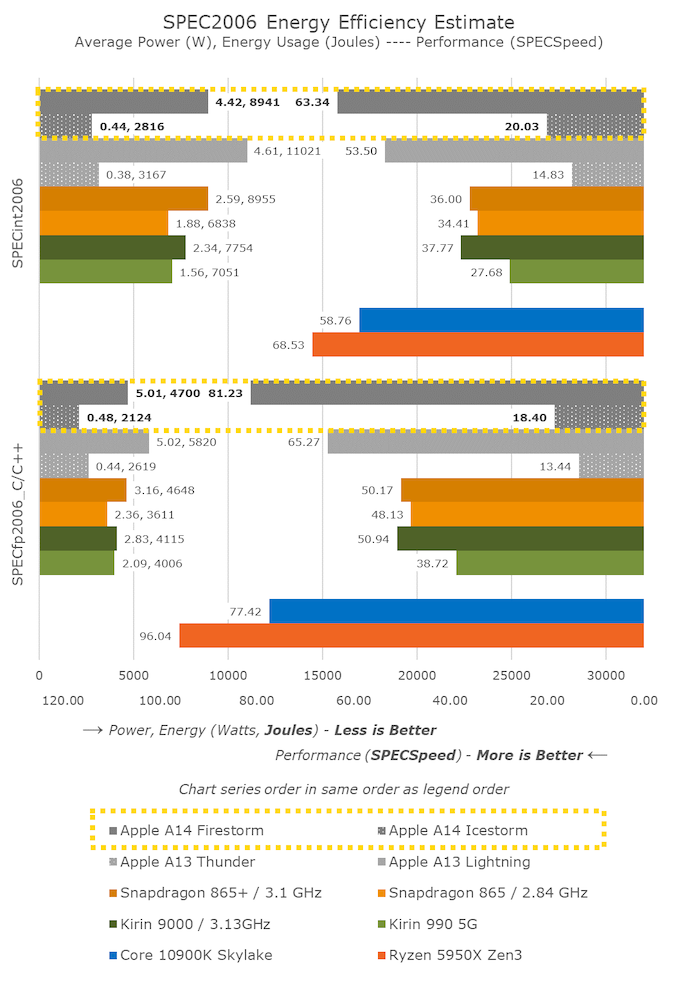Apple Announces The Apple Silicon M1: Ditching x86 - What to Expect, Based on A14
by Andrei Frumusanu on November 10, 2020 3:00 PM EST- Posted in
- Apple
- Apple A14
- Apple Silicon
- Apple M1
Dominating Mobile Performance
Before we dig deeper into the x86 vs Apple Silicon debate, it would be useful to look into more detail how the A14 Firestorm cores have improved upon the A13 Lightning cores, as well as detail the power and power efficiency improvements of the new chip’s 5nm process node.
The process node is actually quite the wildcard in the comparisons here as the A14 is the first 5nm chipset on the market, closely followed by Huawei’s Kirin 9000 in the Mate 40 series. We happen to have both devices and chips in house for testing, and contrasting the Kirin 9000 (Cortex-A77 3.13GHz on N5) vs the Snapdragon 865+ (Cortex-A77 3.09GHz on N7P) we can somewhat deduct how much of an impact the process node has in terms of power and efficiency, translating those improvements to the A13 vs A14 comparison.
Starting off with SPECint2006, we don’t see anything very unusual about the A14 scores, save the great improvement in 456.hmmer. Actually, this wasn’t due to a microarchitectural jump, but rather due to new optimisations on the part of the new LLVM version in Xcode 12. It seems here that the compiler has employed a similar loop optimisation as found on GCC8 onwards. The A13 score actually had improved from 47.79 to 64.87, but I hadn’t run new numbers on the whole suite yet.
For the rest of the workloads, the A14 generally looks like a relatively linear progression from the A13 in terms of progression, accounting for the clock frequency increase from 2.66GHz to 3GHz. The overall IPC gains for the suite look to be around 5% which is a bit less than Apple’s prior generations, though with a larger than usual clock speed increase.
Power consumption for the new chip is actually in line, and sometimes even better than the A13, which means that workload energy efficiency this generation has seen a noticeable improvement even at the peak performance point.
Performance against the contemporary Android and Cortex-core powered SoCs looks to be quite lopsided in favour of Apple. The one thing that stands out the most are the memory-intensive, sparse memory characterised workloads such as 429.mcf and 471.omnetpp where the Apple design features well over twice the performance, even though all the chip is running similar mobile-grade LPDDR4X/LPDDR5 memory. In our microarchitectural investigations we’ve seen signs of “memory magic” on Apple’s designs, where we might believe they’re using some sort of pointer-chase prefetching mechanism.
In SPECfp, the increases of the A14 over the A13 are a little higher than the linear clock frequency increase, as we’re measuring an overall 10-11% IPC uplift here. This isn’t too surprising given the additional fourth FP/SIMD pipeline of the design, whereas the integer side of the core has remained relatively unchanged compared to the A13.
In the overall mobile comparison, we can see that the new A14 has made robust progress in terms of increasing performance over the A13. Compared to the competition, Apple is well ahead of the pack – we’ll have to wait for next year’s Cortex-X1 devices to see the gap narrow again.
What’s also very important to note here is that Apple has achieved this all whilst remaining flat, or even lowering the power consumption of the new chip, notably reducing energy consumption for the same workloads.
Looking at the Kirin 9000 vs the Snapdragon 865+, we’re seeing a 10% reduction in power at relatively similar performance. Both chips use the same CPU IP, only differing in their process node and implementations. It seems Apple’s A14 here has been able to achieve better figures than just the process node improvement, which is expected given that it’s a new microarchitecture design as well.
One further note is the data of the A14’s small efficiency cores. This generation we saw a large microarchitectural boost on the part of these new cores which are now seeing 35% better performance versus last year’s A13 efficiency cores – all while further reducing energy consumption. I don’t know how the small cores will come into play on Apple’s “Apple Silicon” Mac designs, but they’re certainly still very performant and extremely efficient compared to other current contemporary Arm designs.
Lastly, there’s the x86 vs Apple performance comparison. Usually for iPhone reviews I comment on this in this section of the article, but given today’s context and the goals Apple has made for Apple Silicon, let’s investigate that into a whole dedicated section…













644 Comments
View All Comments
mdriftmeyer - Saturday, November 14, 2020 - link
The word is deprecated, not depreciated.Zerrohero - Friday, November 13, 2020 - link
”no upgrade or servicing or any reuse/recycling at all, extremely bad for environment.”Apple does repair MacBooks, including battery replacements. Apple recycles your Apple products for free.
I’m pretty sure that the average lifespan of a MacBook isn’t any shorter than it is for Windows laptops.
Also, Mac volumes are way, way smaller.
If you truly care about the environment, think of the Windows laptops and especially Android phones and their ridiculously short SW support. They are filling the landfills, not Apple products.
I’m also pretty sure that your interest in the environment strangely stops at Apple. Do you eat meat? Do you drive a car? Do you ever fly?
By the way, take a look at Greenpeace’s Green Electronics Rankings. Care to guess which brand is number one of all the big names?
Hint: it starts with an A.
Tomatotech - Friday, November 13, 2020 - link
I don't have a link to hand, but I've seen figures indicating that Apple devices are used for approx 3x longer than Windows devices. Comparing the used prices for Android phones vs iPhones, Macbooks vs Windows laptops, seems to bear this out.A 5 year old 2015 Macbook Pro still fetches high prices, but try selling a 5-year old Windows laptop...
This indicates that the daily use base of Apple laptops could be 2x to 3x higher as a proportion of total laptop daily use than their sales figures indicate.
(That's consumer market only. For business many staff suffer using 5-10 year old windows desktops and laptops that won't get replaced till they break down.)
Oxford Guy - Sunday, December 6, 2020 - link
"A 5 year old 2015 Macbook Pro still fetches high prices"Because it's the last one with a good keyboard and no need for dongle hell?
Oxford Guy - Sunday, December 6, 2020 - link
Also, it has MagSafe and no T2, afaik.ex2bot - Friday, November 13, 2020 - link
Stick with Microsoft and Google. They’re pro-consumer. They love you. They want what’s best for you, not just your money. They’re your corporate mommy. Embrace the sweet, sweet Windows ecosystem (and Android, too) that’s made to nurture you. Because they care about you. They love you and are proud of you. Momma Microsoft. Papa Google.ex2bot - Friday, November 13, 2020 - link
(Some of the above may be /s.)GeoffreyA - Saturday, November 14, 2020 - link
Well, we're living in Brave New World almost. For my part, *all* these companies are rotten eggs. Their job is to make money out of us, so whatever they do is shaped to that end. How kind soever their words are, no matter how sweet, it's with a motive. I think the ones I hate the most are Google and Facebook. Don't be evil indeed. When the dollars start rolling into Mountain View's coffers, when the immoral power over people's lives grows, then it's "do the right thing."I won't defend Microsoft either. I grew up with Windows, so will always have a fondness for it, but Microsoft went off the tracks from the Windows 8 era. As for Apple, I just don't like them. Perhaps it's how they paint themselves as this big humane company, of great heart and greater ideals---but at the bottom, what is it all about? They're just making money, and a lot of it too. Apple's products are not cheap. And I'd say, Microsoft is impotent and too silly: Apple is the one to be alarmed about. They've got genius and a relentless focus, and worst of all, a despotic streak running through them.
Oxford Guy - Sunday, December 6, 2020 - link
"For my part, *all* these companies are rotten eggs."Corporations are soulless non-living financial inventions. They're designed to have no morality so amoral behavior on the part of the owners' class can be rationalized away.
They are financial shields against culpability. The Justice Department, according to insiders on MSNBC, has long had a policy of finding corporations instead of jailing executives when laws are broken.
Oxford Guy - Sunday, December 6, 2020 - link
fining, not "finding"